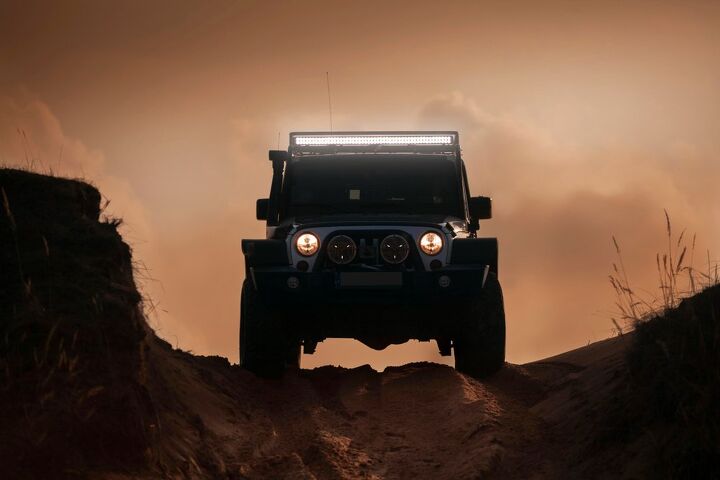How To Mount A Light Bar On Roof Without Drilling

One of the most popular aftermarket accessories among four-wheel off-road enthusiasts is LED lightbars. The advances in LED technology afford amazing lighting performance at remarkably reasonable prices. However, mounting these lightbars poses a problem for some vehicle owners. The question of how to mount a lightbar on a vehicle roof without drilling comes up often.
Several options for mounting a lightbar on a vehicle roof with drilling holes are available in the marketplace. All require some type of clamping system to secure the lightbar. The most popular places to secure a clamp include:
- The roof gutter
- The roof-mounted cargo rack
- Using the third brake light on many pickups
It is understandable that many people don’t want to drill holes in the bodywork of their expensive four-wheel-drive vehicle. This is especially true if the vehicle is leased rather than purchased. Any holes in the vehicle body can potentially incur a penalty when the leased vehicle is returned.
About No-Drill Mount Systems
Finding a way to mount a lightbar on a vehicle without drilling holes presents a challenge. Four-wheel drive vehicles tend to end up in some extreme places. The nature of off-roading induces lots of stress to the mounts and the accessories.
The aerodynamic design of most modern vehicles doesn’t leave a lot of places that anything can be securely clamped to provide a mount for a lightbar. The differences in the body styles and roof structures among vehicle manufacturers add another layer of complexity.
This means that many of the aftermarket no-drill lightbar mounts are vehicle specific. Shopping for a no-drill vehicle mount can be frustrating. Depending on the make and year model of your vehicle, not every manufacturer will have a clamp-on system to fit.
Roof Gutter Mounts – Clamp it On
On some older models of pickups and other four-wheel-drive vehicles, the roof of the vehicle has a drip edge gutter. This makes a convenient place to attach a clamp-on lightbar mount. A simple clamping system is attached to the drip edge gutter and the light bar attaches across the top of the vehicle.
Adapters and spacers are used to fit the lightbar to the clamp mounts. These types of mounts are sturdy and secure when installed according to the manufacturer’s instructions. These types of mounts are quick and easy to install.
The downside to clamp mounts is the gutterless style of roof that is found on almost all new models of off-road vehicles. The smooth look door and roof treatment eliminate the roof gutter channel. The net result is a smooth contour that has nothing to which a clamp can be attached.
Several companies manufacture gutter clamp style lightbar mounts. Some are vehicle make and model specific and the manufacturer may not support every year and model of vehicle. Others are more generic and can be adapted to almost any vehicle with a drip gutter edge on the roof.
Roof Rack Mounts – Getting a Grip on the Lightbar Situation
If your off-roading vehicle is equipped with a cargo rack on the roof, you may find the mounting of a lightbar easier than you think. Clamp systems specifically designed to utilize the tubing of most roof mount racks are easily available.
Most of these clamp system uses a round clamp that attaches to the tubing of the roof-mounted rack. The spacing of the clamps can be adjusted to fit the length of your lightbar. The angle at which the light bar rides is also quickly adjustable.
These clamping systems will fit virtually any lightbar and roof rack. There are clamps for square tubing racks as well that offer the same flexibility and easy installation. Most of these clamping systems are adaptable to any vehicle with a roof rack.
One downside to roof rack mounted lightbars is the location. Since most roof racks sit toward the rear of the vehicle roof, this puts the lightbar nearer the middle of the roof of the vehicle. You may lose some illumination with this location, particularly close to the front of the vehicle.
Unfortunately, not many pickups come equipped with a roof-mounted cargo rack. Mounting a roof rack to a pickup would involve drilling holes, which seems to defeat the purpose of a no-drill light bar mounting system.
An Option for Newer Trucks
Newer model pickups and some SUVs feature a third brake light on the back of the cab. There are companies now offering accessory mounting systems that use this third brake light. Some of these systems replace the third brake light housing with a new unit to which accessories can be mounted.
A mounting system that uses the third brake light also offers the advantage of using the existing wiring harness that serves the third brake light for your LED light bar. This solves the problem of how to route the wire for the LED lightbar without holes as well.
Of course, putting the lightbar at the very back of the cab creates other problems. Some of the forward illumination from the lightbar will be blocked by the roof of the vehicle. The area directly in front of the vehicle will remain without lighting.
Other Options to Consider
If you just cannot bring yourself to drill holes in your vehicle to mount an LED light bar on the roof, you may need to consider other mounting locations. There are several options that are frequently used by off-road enthusiasts to mount lightbars.
Hood Mounts
Mounting kits that clamp to the edge of the vehicle hood are available. This clamp-on style of hood mounts attaches either to the sides or the rear of the hood, depending on the vehicle model. This mounting location puts the lightbar close to the rear of the hood and low on the windshield.
A lightbar in this location doesn’t severely impede forward vision. Some forward illumination, particularly directly in front of the vehicle, may be lost. However, this compromise of location and installation can be a good tradeoff for those that want a clean and hole-free mount.
Grill Mounts
The grill of your vehicle can offer a perfect place to mount an LED lightbar without drilling any holes. These styles of mounts come in different configurations depending on the style of the grill and the make of the vehicle.
One style of grill mount utilizes the existing screw mounts that hold the grill in place. The mounting brackets are installed by unscrewing the existing screws and placing the bracket before returning the screw to its home.
Another style clamps to the grill itself. This mount depends on the strength of the grill to hold the lightbar and on some types of grills, this may not be feasible.
The third style of grill mount does require drilling, but the holes are made behind the grill on the support structures. This may not be a problem because the extra holes are not noticeable and don’t affect the bodywork.
Grill mounted lightbars will provide light up close to the front of the vehicle. However, the lower mounting position may diminish the distance that the light bar is effective.
Bumper or Grill Guard Mounts
If your vehicle is equipped with a push bar or grille guard, this may be the perfect place to mount your light bar. Many grill guards and push bars are aftermarket accessories and some feature pre-drilled mounting holes for light bar attachment systems.
Even if your grill guard or push bar isn’t pre-drilled, a clamp-on style of mount will usually work. Many lightbar manufacturers offer mounting kits made especially for grill guards and push bar installation.
There are some disadvantages to mounting your LED lightbar to the very front of your vehicle. The low location will shorten the effective distance of the lightbar. In addition, having the lightbar out front exposes it to damage. Low limbs, bushes, and other objects can easily impact the lightbar.
Finding the Right Compromise – Let There Be Light
Mounting a lightbar on the roof of a vehicle can be challenging if you require a no-drill solution. Newer vehicles with their aerodynamic designs don’t lend themselves very well to this challenge. You may need to rethink your strategy or consider different options for your lightbar location.

Dennis is a retired firefighter with an extensive background in construction, home improvement, and remodeling. He worked in the trades part-time while serving as an active firefighter. On his retirement, he started a remodeling and home repair business, which he ran for several years.
More by Dennis Howard



























